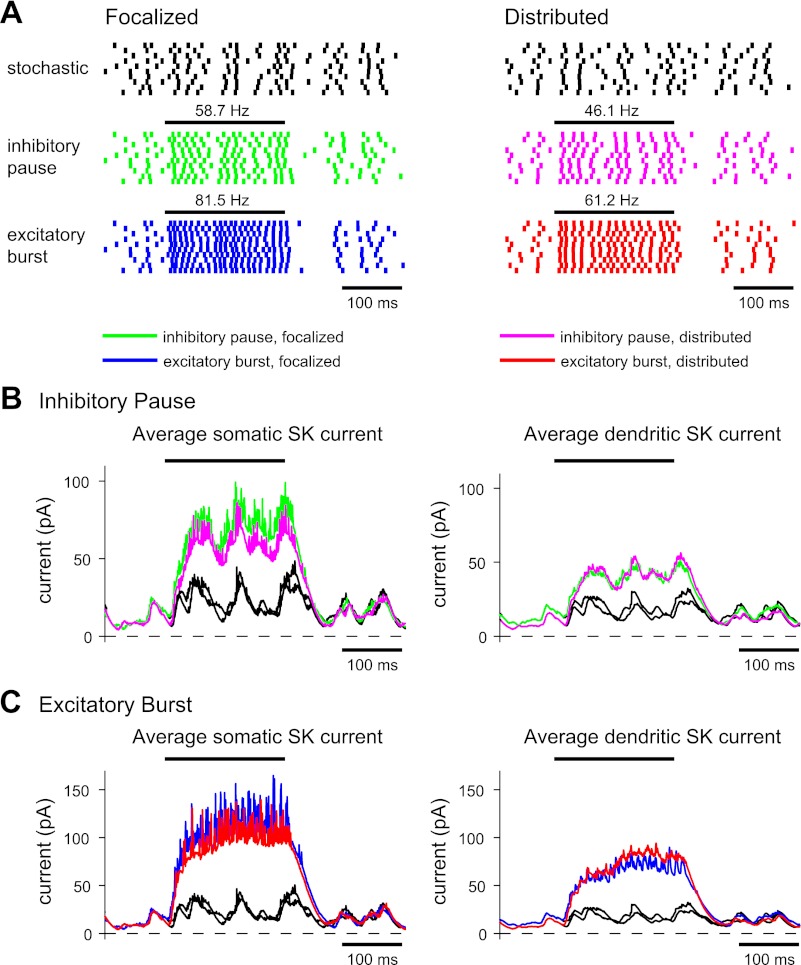Volume 105, May 2011
Lin RJ, Jaeger D. Using computer simulations to determine the limitations of dynamic clamp stimuli applied at the soma in mimicking distributed conductance sources. J Neurophysiol 105: 2610–2624, 2011; doi:10.1152/jn.00968.2010; http://jn.physiology.org/content/105/5/2610.full.
We now replace, in the second to last paragraph in results, “This difference was paralleled by a slightly higher increase in SK current activation for the focalized disinhibition over the distributed case in both the soma (Fig. 9B, left) and the dendrites (Fig. 9B, right)” with “This difference was paralleled by a slightly higher increase in SK current activation for the focalized disinhibition over the distributed case in the soma (Fig. 9B, left), which is likely due to increased somatic calcium inflow at the higher spike rate. In the dendrites, focalized and distributed disinhibition led to nearly identical SK current responses, which were furthermore quite similar to the somatic response profile, but showed diminished transients associated with each action potential (Fig. 9B, right).”
Fig. 9.
Response to an inhibitory input pause or excitatory input burst for focalized or distributed input in the model. A: a 50% decrease in the inhibitory input rate approximately doubled the output spike rate of the model. This increase was slightly higher for focalized inputs, which is likely due to greater excitation on the soma in the focalized case. A 100% increase in the excitatory input rate had an effect similar to that of an inhibitory pause but drove the model to spike at even higher frequencies. B: during the inhibitory pause, the magnitude of the SK was larger due to increased spiking. C: the effect of an excitatory burst was similar to that of an inhibitory pause with the magnitude of the SK current driven even higher by the higher spike rate. In the soma, focalized input led to a slightly larger increase in SK current than distributed input both for inhibitory pauses and excitatory bursts, which was likely due to the higher spike rates achieved with focalized inputs. This effect was not apparent in the dendritic SK current, where the currents appeared somewhat low-pass filtered in comparison to the soma, which is explained by diminished amplitude of backpropagating action potentials. In all cases, the SK current took about 60 ms to relax back to the control trajectory after the end of the input burst.
We also substitute the original incorrect Figs. 8 and 9 with the corrected figures (Fig. 8 corrects panel B, right; Fig. 9 corrects panels B and C, right). The legend for Fig. 8 remains as published. The legend for Fig. 9 has been corrected. The results and conclusions of this study stand.
Fig. 8.
Response to an inhibitory input burst for focalized or distributed input in the model. The horizontal bar above the raster plots indicates the duration of the input burst. The mean firing rate in the control trials was 26.9 Hz for focalized inputs and 23.0 Hz for distributed input. Before the start of the input burst, spike times in the control and patterned trials were exactly the same. A: a 50% increase in the inhibitory input rate caused a nearly complete suppression of spiking to a 1.4-Hz spike rate for focalized input (left) and to a 1.5-Hz spike rate for distributed input (right). For distributed dendritic input, the onset of spike suppression was not as complete during the first 25 ms, and in some trials spikes were still present early during the inhibitory period (arrow). B: during the inhibitory burst, the magnitude of the SK current strongly decreased due to the absence of spikes but returned to the control trajectory when the burst ended. The pattern of SK activation was similar for both the focalized and distributed input conditions. The average SK current across different noise conditions is shown.




